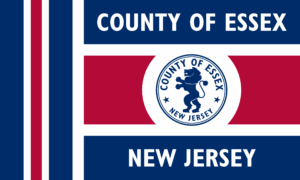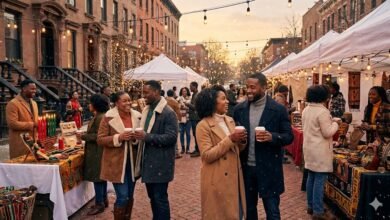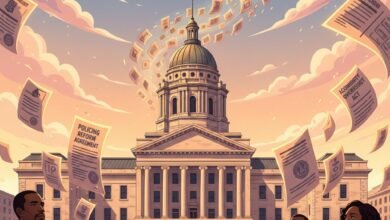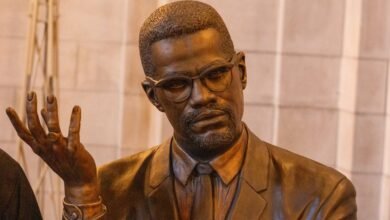
Montclair, NJ: Black Legacy, Creative Fire, and a Town at the Intersection of Culture and Change
Perched along the cliffs of the Watchung Mountains and just 12 miles from New York City, Montclair, New Jersey is a place where jazz legends, abolitionists, artists, and activists have long made a home. Known for its tree-lined streets, independent shops, and vibrant arts scene, Montclair is also a town where gentrification, school equity, and cultural preservation remain daily conversations. It’s a place where legacy meets longing—for visibility, justice, and a future that matches its progressive reputation.
Origin and History
Montclair’s foundation is steeped in movement—through railroads, migration, and activism.
- Lenape Land: The Lenape people originally lived in this region, using the surrounding hills and meadows for seasonal agriculture and travel.
- Dutch & English Settlement: The area was colonized in the 17th century as part of Newark’s expansion. Small villages like Cranetown and Speertown later became part of modern-day Montclair.
- Railroad Suburb: By the 1800s, the arrival of rail lines transformed Montclair into a commuter town for wealthy New Yorkers—alongside a growing Black working-class community.
- Abolitionist Stronghold: Montclair was a key stop on the Underground Railroad and later home to prominent Black intellectuals, activists, and artists.
- Incorporation: Montclair was incorporated in 1868 and today remains one of New Jersey’s most economically and racially diverse suburban communities—though not without tensions.
Demographics
Montclair is often praised for its diversity—but that diversity demands real commitment.
- Population: Approx. 41,000 residents (2020 U.S. Census)
- Cultural Composition: About 60% white, 23% Black, 10% Latinx, and 5% Asian—with one of the state’s highest percentages of multiracial households.
- Languages Spoken: English is primary, but Spanish, Haitian Creole, French, and Yoruba are increasingly spoken among families, caregivers, and immigrant communities.
- Neighborhood Texture: From Upper Montclair’s affluence to South End’s Black legacy, the town includes a wide range of lived experiences—and disparities.
Geographic Location and Size
Montclair is compact, commuter-friendly, and culture-rich.
- Size: 6.3 square miles
- Borders: Surrounded by Bloomfield, Glen Ridge, West Orange, and Verona.
- Transit Access: Multiple NJ Transit train stations connect Montclair to NYC via the Montclair-Boonton Line. Local buses and walkable business districts make it one of NJ’s most transit-accessible suburbs.
Where We Thrive
Montclair’s brilliance comes from its people—and the institutions they’ve built.
- Public Schools: The Montclair Public Schools system is known for its magnet school model, arts integration, and vocal parent base. Yet, equity gaps between Black and white students remain a key issue.
- Arts & Culture: Home to the Montclair Art Museum, Montclair Film Festival, and dozens of independent galleries, bookshops, and theaters. Creatives from Toni Morrison to Stephen Colbert have called Montclair home.
- Black Community Legacy: The South End and Fourth Ward have long been cultural centers for Montclair’s Black residents—home to churches, Black-owned businesses, and decades of activism.
- LGBTQ+ & Intersectional Organizing: Montclair hosts one of the largest suburban Pride events in NJ and has a growing network of intergenerational queer advocacy and youth services.
Fun Facts and Local Gems
- Montclair Art Museum (MAM): A regional cultural anchor featuring American and Native art, plus youth education programs.
- Luna Stage & Vanguard Theater: Independent theater companies committed to social justice, youth mentorship, and diverse storytelling.
- Montclair Film Festival: A nationally respected event that brings indie, global, and documentary filmmakers to the community each spring.
- Crane House & Historic YWCA: A museum and former residence of Montclair’s Black YWCA chapter—now telling the story of race, women, and civic leadership.
Challenges and Change
Progressive branding doesn’t mean equity has been achieved.
- School Segregation & Disparity: Despite desegregation efforts, test scores, discipline data, and opportunity gaps between white and Black students persist.
- Gentrification & Displacement: Rising housing costs and property taxes are pushing out longtime residents—especially elders, renters, and working-class families of color.
- Visibility vs. Voice: Black, immigrant, and LGBTQ+ communities are often celebrated in marketing—but underrepresented in town decision-making, police reform boards, and civic leadership.
- Cultural Preservation: As new development accelerates, many fear losing the architectural, historical, and neighborhood character that defines Montclair’s soul.
Community Voices
“We have a town where Toni Morrison wrote books—but where Black teens still face over-policing and underinvestment. We’re not here for symbolism—we want substance.”
— Deja W., Montclair High School alum and youth organizer
Why Montclair Matters
Montclair matters not because it’s perfect—but because it’s in progress. It’s a test case for whether a suburban town can be truly inclusive—not just diverse on paper, but just in practice. It’s where activism meets art, where youth are speaking up, and where movements are building not just homes—but homecomings.
HFYC uplifts Montclair because the future of equity lives in everyday places—and the work of justice must reach every block, every classroom, every boardroom.
Call to Action
Live in Montclair? Know a youth leader, elder, educator, artist, tenant organizer, or cultural worker shaping what’s next?
Let us help tell their story.
Submit a feature, nominate a changemaker, or reflect on what Montclair means to you—from the South End to Watchung Plaza.







